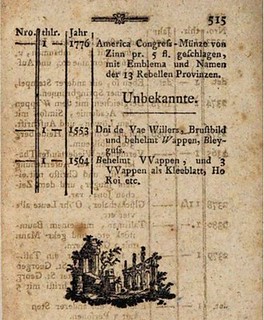
Julia Casey submitted these additional research notes on the 1785 Continental Dollar Sale in Nuremberg. Thank you! More pieces to the puzzle of the origin of the Continental Dollar coins/medals.
-Editor
Michael von Seufferheld and the 1785 Continental Dollar Sale in Nuremberg
 The 1785 catalog for the von Seufferheld collection is the earliest documented sale of a
The 1785 catalog for the von Seufferheld collection is the earliest documented sale of a Continental dollar. This sale has been used by proponents on both sides of the debate to support their theories about the origin and intent for the minting of the Continental dollar pieces. The traditional concept that the Continental dollar was issued as an American dollar is supported by the catalog description of the piece as munze i.e., a coin. As well, a Continental dollar first being offered for sale in Germany supports the more recent perception that these pieces were struck in Europe.
The owner of this collection is identified as Michael von Seufferheld by Joachim Rex in Beiträge zum Buch- und Bibliothekswesen (Contributions to Books and Libraries), Volume 44 (2002). Johann Michael von Seufferheld (1728-1784) was a banker and commercial court assessor in Nuremberg and received an Adelsbrief or nobility status in Vienna in 1771. While his full given name includes Johann, von Seufferheld was commonly listed in literature and records as Michael von Seufferheld.
Von Seufferheld was also a well-known coin collector. In the 1782 publication of Neue Beyträge zur Geschichte und Münzwissenschaft (New Contributions to History and Numismatics) the numismatist Johann Jakob Spiess (Spieß) called him a grosser Thalersammler und Kenner (great Thaler-collector and connoisseur). Von Seufferheld was said to have been friendly with the Swiss (Bernese) historian/numismatist Gottlieb Emmanuel von Haller (1735-1786). Von Haller's biographer, Hans Haeberli, wrote that von Seufferheld would track German auctions for pieces that might be of interest to von Haller.
Gottlieb Emmanuel von Haller was the son of the great Swiss anatomist Albrecht von Haller, and his younger half-brother was the Parisian banker Rudolf Emmanuel von Haller (1747-1833). This trail of breadcrumbs from von Seufferheld to the von Haller family next leads us to Paris and Benjamin Franklin.
Rudolf Emmanuel von Haller corresponded with Franklin and is described on the Founders Online website as being unsuccessful in a bid for his firm to be the primary bankers to the American commission. It is also stated that he was known as a brilliant though not always scrupulous businessman, Haller used his contacts in Holland, England and Paris to speculate broadly on the war. Might the Continental dollar pieces have been struck in an attempt by Rudolf Emmanuel von Haller to impress Franklin and persuade him to engage with Girardot, Haller & Cie.?
It would appear, based on von Seufferheld's 1784 date of death, that this 1785 sale was for estate purposes. This information serves to date von Seufferheld's acquisition of the Continental dollar to 1784 or earlier. While we can see that Von Seufferheld, and/or the cataloger of his collection, placed the Continental dollar within the categorization of a coin. Since von Seufferheld was not alive at the time of the sale we cannot be certain if this designation was made by him or the individual handling the sale of his estate.
However, this does not necessarily confirm that the Continental dollar was struck with the intent to pass as an American coin. If Continental dollar pieces were struck in Europe and first offered to collectors there, some of whom would have believed it to be an American coin. Subsequently, if Continental dollars were offered for sale in England to collectors such as Sarah Sophia Banks, they could have believed it to be a medal. In both cases, Continental dollar pieces were offered to be sold, not to circulate. After all, Sarah Sophia Banks's ledger recorded that they were "never current, struck on speculation in Europe, for sale in America." The intent may have always been that the "Continental dollars" were made to be sold, whether they were sold as "coins" or as "medals" was inconsequential, so long as they were sold.
LINKS:
Neue Beyträge zur Geschichte und Münzwissenschaft, Volume 1
By Johann Jakob Spieß
https://books.google.com/books?id=dJ5MAAAAcAAJ&pg=PA46&dq=%
22grosser+Thalersammler+und+Kenner%22&hl=en&newbks=1&newbks_redir=0
&sa=X&ved=2ahUKEwir5NiIraz5AhVdEFkFHSa2DdAQ6AF6BAgDEAI#v
=onepage&q=%22grosser%20Thalersammler%20und%20Kenner%22&f=false
To Benjamin Franklin from Rodolphe-Emmanuel Haller, 5 September 1778
https://founders.archives.gov/documents/Franklin/01-27-02-0335
To read earlier E-Sylum articles, see:
CONTINENTAL DOLLAR OFFERED FOR SALE IN 1785
(https://www.coinbooks.org/v24/esylum_v24n12a10.html)
MORE ON THE 1785 CONTINENTAL DOLLAR SALE
(https://www.coinbooks.org/v24/esylum_v24n13a08.html)
Wayne Homren, Editor
The Numismatic Bibliomania Society is a non-profit organization
promoting numismatic literature. See our web site at coinbooks.org.
To submit items for publication in The E-Sylum, write to the Editor
at this address: whomren@gmail.com
To subscribe go to: https://my.binhost.com/lists/listinfo/esylum
Copyright © 1998 - 2024 The Numismatic Bibliomania Society (NBS)
All Rights Reserved.
NBS Home Page
Contact the NBS webmaster
| 


